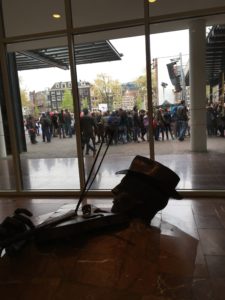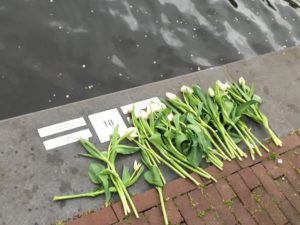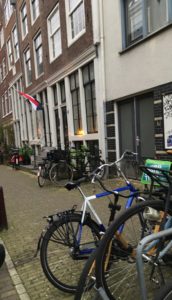
A few words preceded the Silent March, following exquisite music by the Mirando Orchestra, the descendants of a Roma group which began playing before the war. (Today, I learned from a friend that they survived because they were given jobs in the circus, and the Germans liked to attend it). Several personal testimonies followed, but they were brief in the cold wind off the Amstel River.

Everyone needed to get moving. The trams had been stopped all along the route, which was scheduled to last an hour and required brisk walking to ensure that the March reached Dam Square in time for the ceremony there.
A woman and man on horseback led the crowd, followed by drums who kept up a somber, repetitive beat. A mass of school children of all colors followed, each carrying a white tulip. At the very beginning, there was a little chatter among the adults (not the kids!) but it soon fell away. The drum, the shuffling feet, the occasional nearby vehicle were the only sounds. First we marched to the Jewish Historical Museum, once four lively synagogues which have now been combined. Turning right onto what is now a big thoroughfare, we saw the remains of the Jonas Daniel Meijerplein where the hefty Dockworker statue stands. He is the symbolic figure of the February Strike, the only such event in western Europe to protest the first roundup of Jewish people – a roundup that took place right there. Beyond him stands the immense Portuguese Synagogue, thankfully still in use, and not an electric light in the whole establishment, only candles.
 We crossed the bridge and turned right. Eerily, the warning sounds that the bridge was about to be lifted bleeted loudly. This is the same bridge the Nazis raised to isolate the Jonas Daniel Meijerplein for the first roundup. Walking along the Nieuwe Keizersgracht, a small residential canal, we saw the markers at our feet which show the name and age of each person who used to live in the house opposite us. All had been rounded up and murdered. Every few feet, someone quietly read the names.
We crossed the bridge and turned right. Eerily, the warning sounds that the bridge was about to be lifted bleeted loudly. This is the same bridge the Nazis raised to isolate the Jonas Daniel Meijerplein for the first roundup. Walking along the Nieuwe Keizersgracht, a small residential canal, we saw the markers at our feet which show the name and age of each person who used to live in the house opposite us. All had been rounded up and murdered. Every few feet, someone quietly read the names.
The March turned to cross the bridge which lay between us and the broad Amstel River.  The clomping of the horses’ feet and the drums sounded louder, and those still reading the plaques could see the crowd advance over the bridge. We passed near the Carré Theater where numberless Jewish people performed, and crossed The Skinny Bridge, looking back up the River to the plaza where we had begun. It was once a medieval Jewish neighborhood, torn down over great protest to build the City Hall/Opera House.
The clomping of the horses’ feet and the drums sounded louder, and those still reading the plaques could see the crowd advance over the bridge. We passed near the Carré Theater where numberless Jewish people performed, and crossed The Skinny Bridge, looking back up the River to the plaza where we had begun. It was once a medieval Jewish neighborhood, torn down over great protest to build the City Hall/Opera House.
Through the narrow streets we kept marching. People stood on their balconies for a few mi nutes to acknowledge us, but few stayed out. It was too cold. The flags were all at half mast.
nutes to acknowledge us, but few stayed out. It was too cold. The flags were all at half mast.
At Utrechtestraat, I left the March so that I could participate in our old neighborhood’s commemoration, a much smaller and more modest affair than the one at the Dam. It was hard to leave, but I knew that, wherever I am, in whatever country, I will always be walking in their footsteps.
